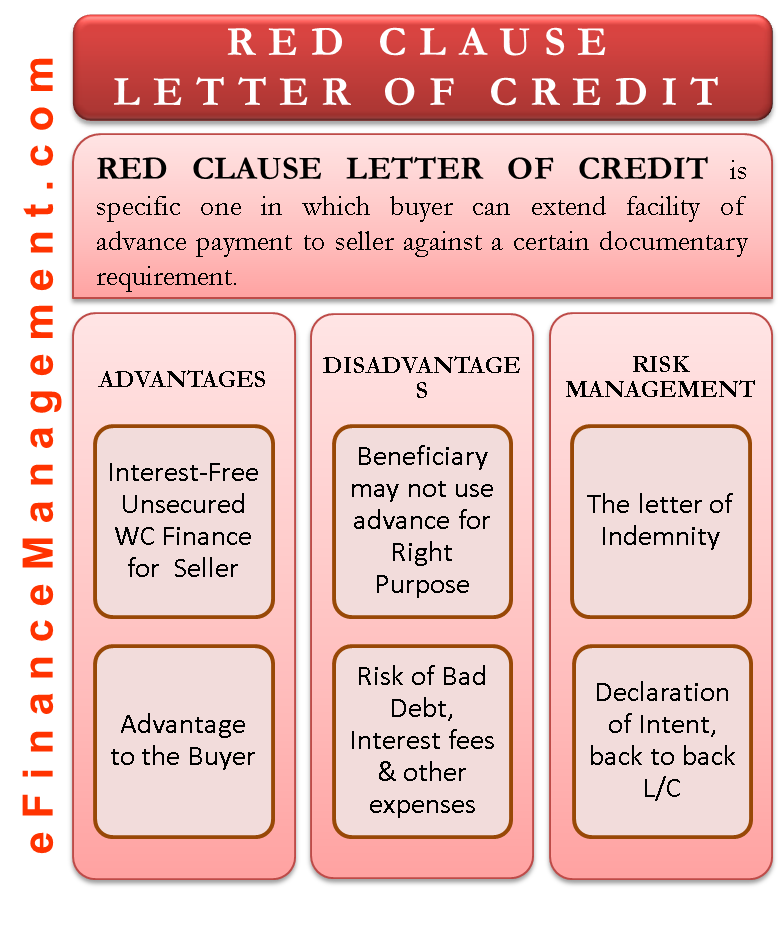Meaning
A red clause letter of credit is a specific type of letter of credit in which the buyer can extend the facility of advance payment to the seller against a certain documentary requirement. In other words, under the red clause letter of credit, the issuing bank will make an advance payment to the exporter, i.e., the seller, before the seller ships the goods to the importer, i.e., the buyer. This is usually done to provide aid to the seller in the form of working capital to purchase raw material, processing and packaging of goods, etc. The advance payment is done against the documentary requirement, which includes written undertaking and receipts.
Thus, this letter of credit facilitates pre-shipment finance for the beneficiary. Originally these letters of credit were written in red ink, so they are called red clause letters of credit.
Advantages of Red Clause Letter of Credit
Interest-Free Unsecured Working Capital Finance for the Seller
The most defining and major benefit of a red clause letter of credit is that the beneficiary, i.e., the seller has easy availability of working capital. If the seller avails a regular means of finance, he may have to pay anywhere between 7% to 15% interest for the financing facility. The seller can save on interest expenses with this letter of credit.
Advantage to the Buyer
When the seller saves interest expenses on working capital, he can pass on this benefit to the buyer. Thus the buyer will have the advantage of a lower-cost product. This is a competitive advantage for the buyer. Thus red clause letter of credit creates a win-win situation for both the buyer and the seller.
Also Read: Green Clause Letter of Credit
Disadvantages in Red Clause Letter of Credit
Beneficiary may not Use the Advance for Right Purpose
The main intent of the red clause letter of credit is to provide finance to the seller for his working capital needs. This way, he can have enough liquidity to pay for raw materials, production costs, labor, etc. It also ensures the buyer that the order placed will be manufactured on time and without any hitches. However, it may happen that the seller will not use the advance payment for its intended purpose. In many cases, it has happened that the seller used the money to pay off his past debt. This actually nullifies the purpose of the red clause letter of credit.
Risk of Bad Debt
When one party gives an advance payment to another party in any transaction, there is always a risk that the receiver may take the money and runoff. This risk intensifies when the seller (receiver of the advance) is from another country. This is an intrinsic risk that a red clause letter of credit carries.
The mechanism of the red clause letter of credit is such that the issuing bank extends an advance to the seller on instructions of the buyer. After the seller fulfills his obligation, the buyer pays to the bank. If the seller doesn’t oblige to his side of the promise, then the issuing bank will ask for the money it has advanced from the buyer. Thus it is very important for the buyer to have trust in the seller. Else this arrangement can actually backfire on the buyer.
Interest, Fees, and Other Expenses
The red clause letter of credit is quite an expensive tool. It carries a fixed fee higher than the regular letter of credit. Also, the advance payment that issuing bank gives to the seller carries an interest rate. At the time of final payment, the buyer has to pay this interest rate plus the letter of credit amount. Furthermore, the issuing bank may ask for collateral from the buyer against this letter of credit. It will also check the buyer’s credibility and past records.
Also Read: Types of Letter of Credit (LC)
Therefore, it is necessary that the buyer does a proper cost-benefit analysis before applying for this letter of credit.

Risk Management for Red Clause Letter of Credit
We can conclude from the above discussion that the red clause LC is a risky payment instrument in international trade. Thus it is important to explore the risk management techniques to insulate against the risk associated with this letter of credit. Following are some of these techniques:
Letter of Indemnity
The buyer can make the seller sign a letter of indemnity. In this scenario, the letter of indemnity will become a document that says – if the seller does not meet the obligations of red clause LC, the buyer will not bear the financial loss (in this case, the advance payment).
Declaration of Intent
The buyer may request to issue a red clause letter of credit embedded with a clause of ‘declaration of intent.’ This means that before drawing the advance payment, the seller has to declare the purpose of the said payment. This step confirms that the seller uses the money for the right purpose. Furthermore, it ensures that the financial liability falls on all three parties, i.e., the seller, the buyer, and the issuing bank. The issuing bank may add a documentary requirement with the declaration of intent.
Back-to-Back Letter of Credit
Despite everything, the seller still feels unsafe giving advance payment. In this case, he can opt for a back-to-back letter of credit instead of a red clause letter of credit. A back-to-back letter of credit allows the beneficiary, i.e., the seller, to utilize the issued letter of credit as collateral to obtain further financing. Using this, the buyer avoids risk, and the seller gets the required financing.


Nice & Useful